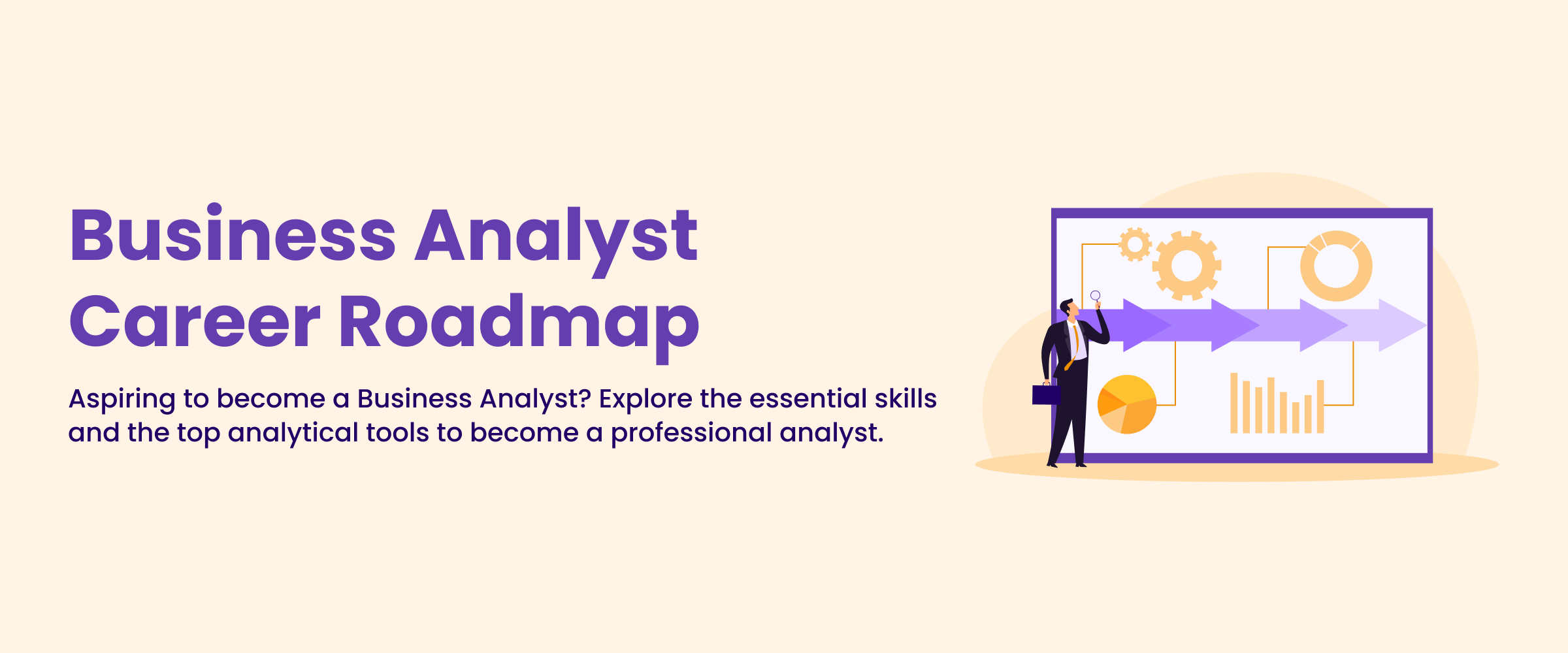Business Analyst Roadmap for Beginners in 2025
Business analytics is one of the fastest-growing job sectors in India. It has become increasingly important in finance, healthcare, and information technology with the growing big data, machine learning, and predictive analytics use. If you are curious about business analytics, follow the roadmap to structure your learning process.
You should focus on acquiring strong analytical thinking and problem-solving skills to act as a bridge between the business world and the technical realm. Our comprehensive business analyst roadmap will equip you with the essential knowledge and skills to navigate your path to success as a business analyst.
Who is a Business Analyst?
A business analyst is a highly skilled professional who acts as a liaison between business stakeholders and IT teams. Their primary responsibility is to analyze business processes, systems, and data to identify areas for improvement or automation. They gather and interpret requirements from stakeholders and collaborate with IT teams to design and implement effective solutions that align with business goals.
Business analysts facilitate communication between different teams, ensuring that projects meet requirements, are delivered on time, and stay within budget. They possess analytical and problem-solving skills to facilitate effective decision-making and drive business success.
Prerequisites for Becoming a Business Analyst
A business analyst should have the desired educational background, technical know-how, and problem-solving skills. They should be able to analyze business challenges and suggest practical solutions that drive growth. This section of the roadmap for business analysts covers the basic prerequisites for becoming a successful professional:
- Educational Qualification
- Bachelor’s Degree: A degree in business administration, finance, economics, IT, computer science, or a related field is essential.
- Master’s Degree (Optional but Preferred): An MBA or a master’s in business analytics, data science, or finance can give you an edge.
- Business Process Knowledge: Understanding how businesses operate, including workflows, market trends, and operational challenges, is crucial for identifying improvement areas.
- Technical Proficiency: Familiarity with SQL, Excel, and reporting tools like Tableau or Power BI aids in data analysis and visualization.
- Project Management Understanding: Knowledge of methodologies like Agile or Scrum helps in managing business requirements efficiently.
- Documentation and Reporting: The ability to create detailed reports, requirement documents, and workflow diagrams supports business decision-making.
How to Become a Business Analyst?
If you are wondering how to become a business analyst, there are a few steps you can take, such as obtaining relevant education, certifications, and skills. It’s important to follow a structured roadmap for business analyst to excel in this field. To kickstart your career and land a promising job, you can consider enrolling in a business analytics course with placement guarantee. This course will equip you with industry-relevant knowledge and skills that can help you secure your desired job role and earn a salary of up to 11 LPA.
Here are the steps you can follow to pursue a career in business analysis:
1. Start With Acquiring Core Business and Data Analysis Skills
To become a successful business analyst, it’s crucial to acquire core business and data analysis skills. These include:
- Data Collection: You need to be proficient in techniques, such as surveys, interviews, and data mining, to gather relevant data from various sources within the organization.
- Data Cleaning: Data cleaning, which is also sometimes referred to as data cleansing or data scrubbing, is a crucial step in data analysis. It involves identifying and correcting errors, inconsistencies, and inaccuracies in a given dataset. This process helps ensure the accuracy and reliability of the data, which leads to more accurate insights and better decision-making.
- Data Manipulation: This process involves a variety of tasks, including aggregating data, joining datasets, and creating calculated fields to support analysis and reporting. By performing these actions, one can derive valuable insights from the data, which can be used to make informed decisions and drive business success.
- Business Process Modelling: Understanding and documenting business processes is crucial for identifying inefficiencies and areas for improvement. Businesses use business process modeling to visualize workflows, identify bottlenecks, and propose optimization solutions. It helps businesses to analyze and document their processes, allowing them to improve their operations and increase their efficiency.
Learn Programming Languages for Business Analytics
After understanding the core business and data analytics skills, the next step in the business analyst roadmap is to become proficient in programming languages. Programming languages are essential for unlocking the full potential of data-driven insights in the realm of business analytics. Here are the three indispensable languages that you should master:
SQL (Structured Query Language)
SQL is a powerful tool used to interact with relational databases. It has an intuitive syntax that allows analysts to retrieve, manipulate, and manage data efficiently. With SQL, you can craft complex queries to extract specific subsets of data, perform aggregations, join multiple tables, and even modify database structures. Here are some key skills and applications of SQL in business analytics:
- Querying databases to retrieve relevant data for analysis.
- Filtering and sorting data using WHERE and ORDER BY clauses.
- Aggregating data with functions like SUM, AVG, and COUNT.
- Performing joins to combine data from multiple tables.
- Modifying database structures with DDL (Data Definition Language) commands.
Python
Python has emerged as a go-to language for business analysts due to its versatility and rich ecosystem of libraries tailored for data analysis, machine learning, and automation. The language’s clear syntax and ease of use make it an accessible option for beginners while also providing advanced capabilities for experienced analysts. Below are some key skills and applications of Python in business analytics:
- Data manipulation and cleaning using libraries like Pandas.
- Statistical analysis and hypothesis testing with SciPy and StatsModels.
- Visualization of data insights using Matplotlib and Seaborn.
- Machine learning modeling with sci-kit-learn.
- Automation of repetitive tasks through scripting and scheduling.
R Programming
R is a popular choice for business analysts who work on statistical computing and graphics. It is well-known for its ability to perform exploratory data analysis and advanced statistical modeling. R has a wide range of packages that will allow you to conduct in-depth data exploration and hypothesis testing. Following are some key skills and applications of R in business analytics:
- Exploratory data analysis (EDA) using functions like summary(), str(), and plot().
- Statistical modeling with packages, such as lm() for linear regression and glm() for generalized linear models.
- Data visualization through ggplot2 for creating elegant and customizable plots.
- Time series analysis and forecasting with packages like Forecast and Prophet.


Master Data Visualization Tools
The business analyst roadmap is incomplete without learning about data visualization tools. The ability to effectively visualize data is crucial in the field of business and data analytics. Data visualization tools can help you create interactive dashboards, explore trends in complex datasets, and present insights to stakeholders. By mastering these tools and honing your visualization skills, you can be better equipped to tackle the challenges of the ever-evolving business landscape and drive meaningful impact within your organization.
Here are the essential data visualization tools you should know as a business analyst:
- Tableau: Tableau is renowned for its intuitive interface and powerful capabilities that allow analysts to create visually stunning dashboards and reports. Its drag-and-drop functionality makes it easy to explore data and uncover insights, while features like interactive filters and drill-down capabilities empower stakeholders to delve deeper into the data.
- Microsoft Power BI: Power BI offers a comprehensive suite of tools for business intelligence and analytics, integrated seamlessly with the Microsoft ecosystem. Its robust features, including natural language queries and AI-powered insights, empower analysts to transform raw data into insightful reports and interactive dashboards with ease.
Develop Proficiency in Data Collection & Management Tools
As a business analyst, mastering data collection and management is critical for delivering data-driven insights. Here are three must-have tools that you should know how to use:
- Microsoft Excel: It is a versatile and powerful platform that goes beyond being a simple spreadsheet tool. The Excel formulas allow analysts to efficiently clean, manipulate, and analyze data. From basic data entry and validation to complex calculations and modeling, Excel should remain a fundamental tool in your toolkit.
- MySQL: It is an open-source relational database management system widely used for storing and managing structured data. With the increasing accumulation of vast amounts of data, analysts need to be proficient in SQL to extract valuable insights from databases. MySQL enables analysts to write complex queries to retrieve and manipulate data, which leads to deeper analysis and reporting.
- Oracle: It is a leading provider of enterprise-grade database solutions, offering powerful tools for data management and analysis. Large organizations often have Oracle databases that require proficiency in SQL and Oracle-specific tools for querying and analyzing data effectively. By mastering Oracle, you can unlock the full potential of enterprise data assets and drive strategic decision-making.
Gain Expertise in Business Analysis Techniques
Business analysts utilize analysis techniques to identify the organizational needs and develop strategies to deliver the best possible results. By using these techniques, businesses can gain valuable insights into their operations, improve their decision-making processes, and ultimately increase their profitability and competitiveness in the market. Here are a few popular business analysis techniques you should know with the help of the business analyst roadmap:
- SWOT: SWOT analysis is a strategic tool used to identify an organization’s strengths, weaknesses, opportunities, and threats. By analyzing these factors, analysts can develop strategies that leverage strengths, mitigate weaknesses, capitalize on opportunities, and minimize threats.
- CATWOE: CATWOE is an acronym for Customers, Actors, Transformation process, Worldview, Owners, and Environmental constraints. It’s a powerful technique used to identify stakeholders and their concerns, which will help you develop a comprehensive understanding of the problem.
- MOST: MOST stands for Mission, Objectives, Strategies, and Tactics. It’s a framework used to define an organization’s goals, develop strategies to achieve them, and create tactics to execute those strategies.
- PESTLE: PESTLE analysis is a technique used to identify the Political, Economic, Sociocultural, Technological, Legal, and Environmental factors that impact an organization. By analyzing these factors, you can develop strategies that leverage opportunities and mitigate risks associated with these factors.
- BPM: Business Process Management (BPM) is a methodology used to identify, design, execute, monitor, and optimize business processes. By analyzing and optimizing business processes, organizations can improve efficiency, reduce costs, and increase customer satisfaction.
Familiarize Yourself with Business Analysis Tools
As a business analyst, you require proficiency in specialized tools to gather requirements, manage projects, and communicate with stakeholders. Here are the four essential business analysis tools that will streamline your approach:
- Microsoft Visio: It is a diagramming tool used by business analysts to create professional-looking diagrams that communicate complex concepts to stakeholders. With its extensive library of shapes and templates, Visio provides an adaptable platform for visualizing and documenting requirements across the project lifecycle.
- JIRA: It is a popular project management tool for Agile teams. It will help you collaborate with stakeholders, prioritize tasks, track progress, and resolve issues efficiently. JIRA provides a centralized platform for managing requirements and project deliverables, enabling teams to deliver high-quality software products on time and within budget.
- Scrum: It is an Agile framework utilized in software development projects for iterative project management. Scrum is crucial for collaborating with cross-functional teams and delivering value to stakeholders. By participating in Scrum ceremonies, such as sprint planning, daily stand-ups, sprint reviews, and retrospectives, you can ensure alignment between business objectives and development efforts, prioritize requirements, and adapt to changing requirements and priorities throughout the project lifecycle.
- Kanban: It is a visual method to optimize workflow efficiency and streamline work delivery. It helps in identifying bottlenecks and improving processes by visualizing requirements, tasks, and deliverables. Kanban boards limit WIP, prioritize tasks, optimize resource utilization, reduce cycle times, and deliver value to stakeholders effectively.
Strengthen Your Skills With Projects
As a business analyst, practical experience through projects can strengthen your skillset and showcase your capabilities to employers. Projects allow you to apply various business analyst skills in a practical setting, build a well-rounded skillset, and gain experience in requirements gathering, data analysis, process modeling, communication, and project management.
The final step of the business analyst roadmap is working on the following projects:
Roles and Responsibilities of a Business Analyst
A business analyst acts as a link between the needs of the business and technical solutions. They evaluate processes, collect requirements, and suggest strategies to enhance efficiency and promote success within the organization. Here are the primary roles and responsibilities of a business analyst:
- Identifying business needs and objectives
- Gathering and documenting requirements from stakeholders
- Analyzing data to derive meaningful insights
- Proposing solutions to improve processes and systems
- Collaborating with teams to implement business strategies
- Conducting risk analysis and feasibility studies
- Monitoring project progress and making necessary adjustments
- Ensuring alignment between business goals and technology solutions
Business Analyst Salary Scope
Business analysts in India earn competitive salaries based on experience, industry, and expertise. With increasing demand across IT, finance, and consulting, professionals in this field can expect significant growth opportunities and higher pay scales over time. The table below shows the approximate salary range for business analysts at different experience levels.
| Experience Level | Approximate Annual Salary (INR) |
| Entry-Level (0-2 years) | ₹4 LPA – ₹7 LPA |
| Mid-Level (3-7 years) | ₹8 LPA – ₹15 LPA |
| Senior-Level (8+ years) | ₹18 LPA – ₹30 LPA |
| Consultant/Manager | ₹25 LPA – ₹50 LPA |
Conclusion
Becoming a business analyst requires a combination of academic background, training, and hands-on experience. It is a field that demands a thorough understanding of various methodologies and techniques to analyze data and find solutions to complex business problems. By following a business analyst roadmap, you can unlock endless opportunities to grow and excel in the field of business analytics. With the help of an online business analytics course, you can pave your way to success.
FAQs
A business analyst typically starts as a junior analyst, progressing to senior analyst roles, then becoming a business analytics manager. With experience, they can move into leadership positions like product owner, consultant, or even chief operations officer (COO).
Business analysis follows a structured approach to identify challenges, assess data, and implement solutions for better decision-making and efficiency. The five key stages include:
a) Identifying business needs
b) Gathering requirements
c) Analyzing data
d) Proposing solutions
e) Implementing changes
No, a business analyst role spans multiple industries, including finance, healthcare, and retail. However, IT business analysts focus on technology-driven solutions, requiring knowledge of software development, databases, and system integrations.
No, business analytics does not always require coding. However, knowledge of SQL, Python, or R can be beneficial for data analysis. Many tools, such as Power BI and Tableau, help business analysts work efficiently without programming skills.
Yes, business analysts earn competitive salaries, with pay increasing based on experience, industry, and expertise in data analytics and strategic decision-making. Senior analysts and consultants often receive higher compensation, especially in the finance and IT sectors.







